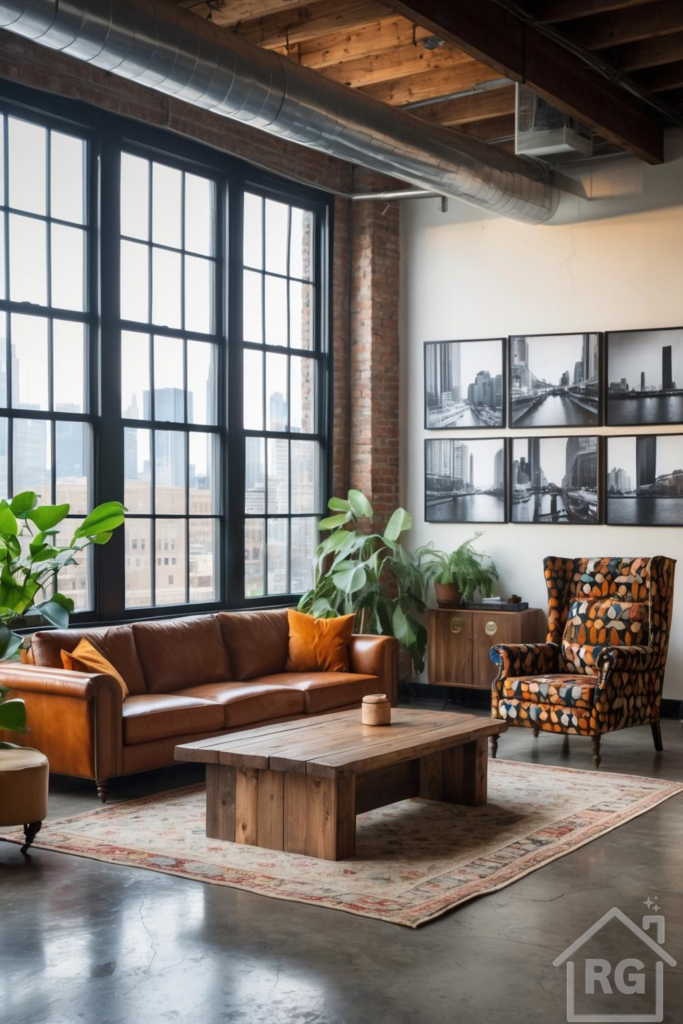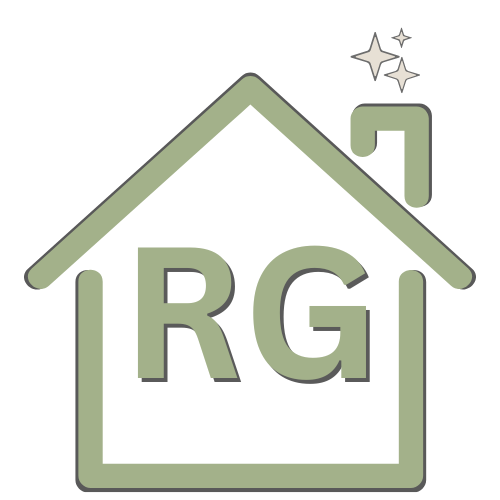
Embracing the Raw Elegance of Industrial Loft Design
Industrial design, born from the conversion of old factories, warehouses, and industrial buildings into living spaces, celebrates a raw, unfinished aesthetic that is both edgy and sophisticated. It’s a style characterized by open layouts, exposed structural elements, and a harmonious blend of weathered wood, aged metal, exposed brick, and polished concrete.
The allure of industrial style lies in its honesty – materials are showcased for what they are, and functionality often dictates form. The living room featured in our inspiration perfectly encapsulates this spirit, merging rugged textures with comfortable furnishings and personal touches to create a space that is both visually striking and deeply inviting.
The Cornerstones of Industrial Chic: Materials and Textures
The soul of industrial design is found in its materials. Creating an authentic industrial feel means embracing imperfections and celebrating the inherent beauty of utilitarian surfaces. Key elements include:
- Exposed Brick: A hallmark of the style, exposed brick walls, like the one featured, add immense character, texture, and a touch of historic warmth. The ruddy tones of the brick provide a perfect backdrop for both dark and light furnishings. Pro Tip: If you don’t have existing brick, consider using brick veneers or high-quality wallpaper for a similar effect.
- Polished Concrete: The floor in this room, likely polished concrete, offers a sleek, durable, and modern counterpoint to the rustic brick. Its cool gray tones reflect light, contributing to the airy feel despite the robust materials. Alternatives include large-format matte gray tiles or even stained concrete.
- Reclaimed and Rustic Wood: Wood, especially with a story to tell, is crucial. The substantial coffee table, crafted from what appears to be reclaimed wood, grounds the seating area. Its natural grain and imperfections add warmth and a tactile quality. Look for pieces with visible joinery or a slightly distressed finish. Ceiling beams, if present or added, further enhance this element.
- Metal Accents: Metal is indispensable. Notice the black metal frames of the expansive warehouse windows, the exposed silver ductwork running along the ceiling, and potentially subtle metal details in furniture legs or lighting. Steel, iron, and even copper can be used for structural elements, window frames, staircases, light fixtures, and furniture.
- Leather: A rich cognac leather sofa, as seen here, introduces a touch of classic comfort and luxury that ages beautifully, developing a unique patina over time. Leather’s smooth texture contrasts wonderfully with rougher elements like brick and wood.
Furnishing Your Industrial Haven: Comfort Meets Character
Furniture in an industrial setting should be a blend of comfort, functionality, and strong silhouettes. It’s about finding pieces that can hold their own against the backdrop of bold architectural features.
- The Anchor Sofa: A comfortable, generously sized sofa is key. The deep-seated leather sofa in a warm cognac hue is an excellent choice, offering both visual weight and inviting comfort. Consider styles like the Chesterfield for a vintage touch or a more streamlined track-arm sofa for a modern industrial look.
- Statement Seating: Don’t shy away from a bold armchair. The patterned wingback chair in the image adds a surprising and delightful pop of color and personality, preventing the space from feeling too monochromatic or overly masculine. It demonstrates how you can inject individuality into the industrial framework.
- The Coffee Table: Opt for something substantial and textural. A chunky wooden coffee table, perhaps with metal accents, or even a concrete-topped table, works well. Functionality is important, so ensure it’s appropriately scaled to your sofa.
- Storage with Style: Think vintage lockers, apothecary cabinets, or simple wooden or metal shelving units. The wooden sideboard in the image provides closed storage while maintaining the rustic-meets-refined aesthetic.
The Industrial Color Palette: Neutral Foundations with Warm Infusions
While often perceived as dark and moody, industrial color palettes are more nuanced. They are typically built on a neutral base with carefully chosen accents to add warmth and personality.
- Core Neutrals: The gray of concrete, the white or off-white of painted walls (providing a bright contrast to darker elements), and the black of metal window frames or accents form the foundation.
- Earthy Warmth: The rich browns of leather and wood, along with the varied reds and oranges of exposed brick, infuse the space with warmth and prevent it from feeling cold or sterile.
- Strategic Pops of Color: As demonstrated by the burnt orange throw pillows and the vibrant pattern on the armchair, accent colors can bring energy and personality. Deep greens from plants, mustard yellows, or even a touch of deep blue can work beautifully.
Illuminating the Space: Light, Bright, and Atmospheric
Lighting is critical in industrial design, especially given the style’s origins in large, open factory floors. The goal is to create a space that is both well-lit and atmospheric.
- Maximize Natural Light: Large, unadorned windows are a signature feature. The Crittall-style or warehouse windows in the image are perfect, flooding the space with light and offering expansive city views. Keep window treatments minimal – simple roller blinds or even bare windows are often best.
- Layered Artificial Lighting: A combination of light sources will create depth and ambiance. Consider:
- Pendant Lights: Think iconic industrial pendants with metal shades, exposed Edison bulbs, or cage designs. These are great over dining areas or kitchen islands if part of an open plan.
- Floor and Table Lamps: Choose lamps with a utilitarian or vintage feel – tripod floor lamps, pharmacy-style lamps, or task lighting with articulated arms.
- Track Lighting or Spotlights: These can highlight architectural features or artwork and fit the functional aesthetic.
Accessorizing the Industrial Loft: Personality and Softness
Accessories are where you can truly personalize your industrial space and add layers of comfort and visual interest. They help to soften the harder edges of the style.
- Lush Greenery: Large potted plants, like fiddle leaf figs or monsteras, are essential. They bring life, color, and an organic softness that beautifully contrasts with the harder industrial elements.
- Textiles for Warmth: Soft furnishings are key to making an industrial space feel cozy.
- Area Rugs: A well-chosen rug, like the distressed traditional-style rug in the image, defines the seating area, adds warmth underfoot, and introduces pattern and color. Jute, sisal, or even a cowhide rug can also work.
- Throws and Pillows: Layer textures with throw blankets (chunky knits, faux fur, wool) and pillows in complementary colors and varied materials (velvet, linen, canvas).
- Wall Decor: Make your walls speak to your style.
- Gallery Walls: A collection of black and white photography, like the cityscapes shown, adds a sophisticated, personal touch.
- Large-Scale Art: Abstract paintings or oversized prints can make a bold statement.
- Mirrors: Large, metal-framed mirrors can amplify light and create an illusion of even greater space.
- Vintage and Found Objects: Scour flea markets and antique shops for unique pieces that tell a story – old gears, architectural salvage, vintage signage, or antique maps. These items add character and a sense of history.
Bringing It All Together: Tips for Your Industrial Transformation
Creating an industrial-style living room is about balancing the raw with the refined, the old with the new, and the functional with the comfortable. Here are key takeaways:
- Start with the Bones: If you have existing features like brick walls or concrete floors, highlight them. If not, consider how you can introduce these essential textures.
- Choose Anchor Furniture Wisely: Invest in a few high-quality, statement pieces like a durable leather sofa or a unique coffee table that will stand the test of time.
- Layer Textures: This is crucial. Mix smooth leather with rough wood, sleek metal with soft textiles, and hard concrete with plush rugs to create depth and interest.
- Embrace Imperfection: Don’t strive for everything to be perfectly matched or pristine. The charm of industrial style lies in its lived-in, slightly rugged character.
- Personalize: Use art, plants, and accessories to reflect your personality and make the space truly feel like your home.
The industrial loft aesthetic offers a unique opportunity to create a home that is both stylish and full of character. By thoughtfully combining materials, textures, and furnishings, you can achieve a look that is timeless, inviting, and uniquely yours.
Whether you live in a true loft conversion or a more conventional home, incorporating elements of industrial design can bring a touch of urban sophistication and raw elegance to your living space. Ready to start your transformation?
